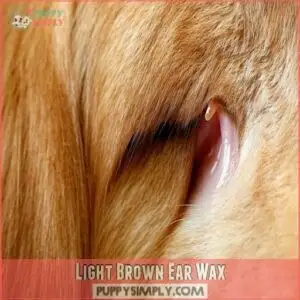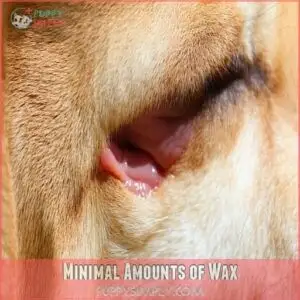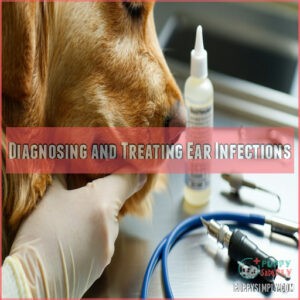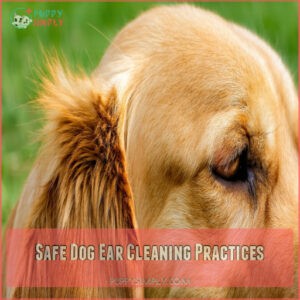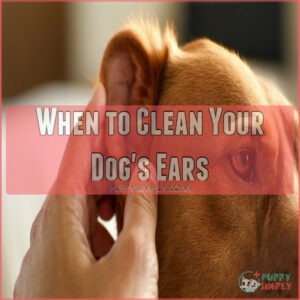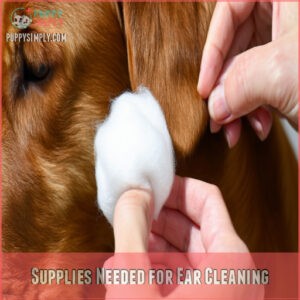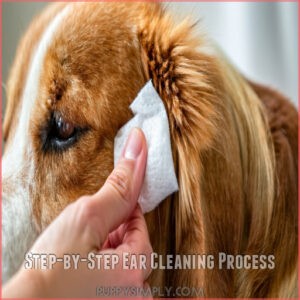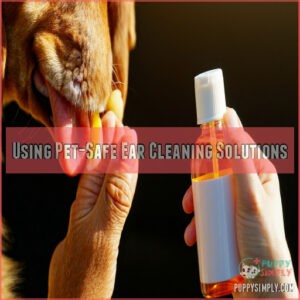This site is supported by our readers. We may earn a commission, at no cost to you, if you purchase through links.
 You’ll find that healthy dog ear wax is typically light yellow or pale brown and feels a bit like petroleum jelly.
You’ll find that healthy dog ear wax is typically light yellow or pale brown and feels a bit like petroleum jelly.
A little is normal, but a lot isn’t.
If your dog’s ear wax is dark brown, black, or red, or if it smells funky, it’s time to see the vet.
These could be signs of an infection or ear mites.
Itching, scratching, and head shaking are other clues something’s up.
Remember, never use cotton swabs to clean your dog’s ears – you could cause damage.
Curious about safe cleaning methods and what else your dog’s ear wax might be telling you?
There’s more to learn.
Table Of Contents
- Key Takeaways
- What is Dog Ear Wax
- Normal Dog Ear Wax Colors
- Abnormal Dog Ear Wax Colors
- Dog Ear Wax Vs Ear Mites
- Diagnosing and Treating Ear Infections
- Safe Dog Ear Cleaning Practices
- When to Clean Your Dog’s Ears
- How to Clean Your Dog’s Ears
- Causes of Abnormal Dog Ear Wax
- When to See a Veterinarian
- Frequently Asked Questions (FAQs)
- How do you get earwax out of a dog’s ear?
- Why is there brown gunk in my dog’s ear?
- How do you get rid of brown yeast in dogs’ ears?
- Why does my dog have brown discharge?
- Is it normal for dogs to have a lot of earwax?
- What is the brown gunk in my dog’s ears?
- What color should dogs’ ear wax be?
- How often should a dog’s ears be cleaned?
- Are there any risks associated with cleaning a dog’s ears?
- What are the signs that a dog’s ears are infected?
- Conclusion
Key Takeaways
- You’ll find healthy ear wax is light yellow or pale brown and slightly greasy. Darker colors, redness, or a bad smell signal a problem like an infection or ear mites.
- Regularly check your dog’s ears for changes in wax color, odor, and amount. Excessive scratching, head shaking, and discharge are signs of potential issues.
- Clean your dog’s ears with a vet-approved cleaner and cotton balls, wiping only the visible wax. Never use cotton swabs, as they can cause damage.
- Consult your vet for diagnosis and treatment if you notice any abnormalities. Early detection and treatment prevent serious complications.
What is Dog Ear Wax
Your dog’s ear wax, also known as cerumen, is a natural substance that protects their ear canal by trapping dust, bacteria, and other unwanted particles.
Just like the wax in your own ears, your dog’s ear wax helps keep their ears clean and healthy by acting as a natural filter and waterproofing agent.
Composition of Ear Wax
Your dog’s ear wax (cerumen) is like a protective soup, mixing together oils from special glands, dead skin cells, and natural compounds.
This unique blend helps keep your pup’s ears healthy.
As these secretions build up in the ear canal, they create different types of wax with varying textures and colors.
It’s not just gunk – it’s a sophisticated biological mixture working hard to protect your dog, and this mixture is a result of a unique blend.
Function of Ear Wax
Ever wonder why your furry friend has ear wax?
This natural secretion is like a tiny cleaning crew working 24/7.
Your dog’s ear wax production creates a protective barrier that catches dust and dirt before they can cause trouble.
It’s also great at ear lubrication, keeping the canal healthy and flexible.
Plus, this natural cleansing system helps remove debris while fighting off unwanted bacteria.
Normal Ear Wax Characteristics
When checking your pup’s ear wax color, knowing what’s normal helps spot trouble early.
Natural wax production creates a light brown or pale yellow substance that’s slightly greasy but not excessive.
A healthy ear canal should look pink with minimal wax buildup, showing good ear health.
Here’s what to expect from normal dog ear wax:
- Texture feels semi-soft, like petroleum jelly
- Color ranges from light yellow to pale brown on the ear wax color chart
- Amount is minimal with no strong odor
Think of it like your car’s oil – just enough to keep things running smoothly.
Normal Dog Ear Wax Colors
You’ll be relieved to know that healthy dog ear wax typically appears light brown or pale yellow, with a semi-soft, slightly greasy texture that helps protect your pup’s ears.
Just like humans, your dog’s ears need this natural wax to trap dust and debris while keeping the ear canal clean and healthy.
Light Brown Ear Wax
Noticing some earthy-toned wax in your pup’s ears? Light brown dog ear wax is usually a sign everything’s working just right.
Here’s what normal ear wax tells you:
- Natural protective barrier working to trap debris and bacteria
- Healthy canine ear care system in action
- Proper wax buildup prevention happening naturally
- Good ear health tips being followed
Remember, consistency in color and minimal amounts are key indicators that your furry friend’s ears are doing their job perfectly.
Light Yellow Ear Wax
When you peek into your pet’s ears, a light yellow wax is usually a welcome sight.
This common dog ear wax color suggests healthy ear function – it’s Mother Nature’s way of keeping those ear canals clean and protected.
For ongoing ear health, choosing the best dog ear cleaners is essential.
While some yellow discharge is normal, watch for changes in consistency or amount.
A light, waxy coating means your pup’s ears are doing their self-cleaning job perfectly.
Minimal Amounts of Wax
Most healthy dogs maintain minimal wax production in their ear canals – just enough to keep things running smoothly.
Your pup’s ear health depends on this delicate balance.
A light coating that barely catches your eye means the natural canal cleaning system is working.
Small amounts reduce infection risks and promote ear hygiene.
Normal dog ear wax shouldn’t block your view of the pink canal.
Minimal dog ear wax lets you spot problems early.
- A light coating that barely catches your eye means the natural canal cleaning system is working
- Small amounts reduce infection risks and promote ear hygiene
- Normal dog ear wax shouldn’t block your view of the pink canal
- Minimal dog ear wax lets you spot problems early, which is crucial for maintaining your pup’s ear health and overall well-being.
Abnormal Dog Ear Wax Colors
You’ll want to watch out for unusual ear wax colors in your dog,
Dark Brown or Black Ear Wax
Your dog’s dark brown or black ear wax could signal trouble brewing.
While some wax buildup is normal, these darker colors often point to ear mites or a yeast infection needing attention.
For a quick overview, check this helpful dog earwax color chart.
A quick look at your dog’s ear wax color chart can help spot issues early, but the real story needs a vet’s trained eye.
They’ll check that ear canal damage isn’t lurking behind that dark ear discharge and recommend the right ear wax removal approach to get those ears healthy again.
Brown Ear Wax With Odor
When you spot smelly brown ear wax, it’s like your pup’s ears are waving a red flag.
That funky brown discharge and foul smell mean it’s time for action.
- Musty or yeasty odors often signal a brewing ear infection that needs attention
- Sweet or rancid smells could point to bacteria making themselves at home
- Dark brown wax with an unpleasant odor might mean ear mites are the culprits
Yellow Ear Wax and Infection
When you spot yellow ear wax in your pup’s ears, it’s time to pay attention.
While a tiny bit of yellow discharge is normal, excessive moist buildup often signals trouble brewing.
For more information, review this helpful dog earwax color chart.
Here’s what those yellow signs mean:
| Warning Sign | What It Means | Action Needed |
|---|---|---|
| Moist & Yellow | Bacterial Growth | Vet Visit |
| Yellow + Odor | Active Infection | Immediate Care |
| Thick & Crusty | Wax Buildup | Professional Cleaning |
| Yellow + Green | Severe Infection | Emergency Vet |
| Watery Yellow | Early Infection | Monitor Closely |
Notice excessive yellow wax? Don’t wait – your vet should check it out before it gets worse.
Red Ear Wax and Blood
Ear-canal redness, coupled with red dog ear wax color, often points to bleeding.
This could be due to ear trauma like scratching, a bug bite, or an infection .
Red wax symptoms may also include blood clots and excessive dog ear wax buildup.
A vet visit is necessary to pinpoint the bleeding causes and rule out serious issues .
- Infection signs: Ear wax discharge, dog ear wax smell.
- Consider: Recent injuries, foreign objects.
- Don’t delay: Bleeding can indicate bigger problems.
- Vet check: Essential for proper diagnosis and treatment.
Green Ear Wax and Infection
That icky green goo in your dog’s ears is a major red flag.
It’s a sign that a nasty yeast infection or bacterial ear infection is brewing.
This vibrant ear wax color, coupled with a funky ear odor, and excessive wax buildup, points to dog ear infection symptoms.
Don’t wait; a vet visit is necessary to tackle these fungal diseases and restore ear health.
Effective dog ear infection home remedies can also provide relief and support the healing process.
Gray or White Ear Wax and Ear Mites
Gray or white earwax can be a telltale sign of ear mites.
These tiny invaders make your dog’s ears their home, wreaking havoc and causing serious discomfort.
Let’s break down why you need to tackle this head-on:
- Intense itching drives your dog crazy.
- Constant scratching leads to more problems.
- Hearing loss becomes a real threat.
- Ear mite treatment brings peace of mind.
Ear mites cause a characteristic dark, crumbly discharge, unlike typical dog ear wax.
Look for mite infestation signs like excessive scratching and head shaking.
If you spot these changes, consult your vet for proper ear mite treatment dogs.
Addressing wax buildup causes and focusing on ear canal health is essential.
Don’t wait; protect your furry friend’s ears today!
Dog Ear Wax Vs Ear Mites
You’ll learn how to tell the difference between regular earwax and those pesky ear mites, so you can get your pup the right treatment.
Knowing what to look for will help you spot the difference between simple wax and something more serious like mites.
Identifying Ear Mites
Itchy ears? Could be those microscopic monsters—ear mites! Let’s become mite detectives.
A vet visit with a microscope is your best bet for diagnosis, revealing those creepy crawlies. Look for tell-tale dry, coffee-ground-like ear discharge and excessive scratching.
Here’s a quick guide for at-home mite symptom spotting:
| Sign | Look For | Next Step |
|---|---|---|
| Itching | Excessive scratching | Vet visit |
| Discharge | Coffee grounds | Wax analysis |
| Behavior | Head shaking | Parasite control |
Ear Mite Infestation Symptoms
So, you suspect ear mites? Let’s talk symptoms. Dog ear mites cause serious ear irritation, making your dog’s ears itchy and prone to vigorous scratching.
You’ll likely notice your dog shaking their head more than usual. The telltale sign? A dark, crusty ear discharge that looks like coffee grounds. This, combined with itchy ears and constant dog ear scratching, points in the direction of an infestation.
Quick action is key!
| Symptom | What You See | What Your Dog Feels |
|---|---|---|
| Ear Discharge | Dark, crusty | Itchy, uncomfortable |
| Itchy Ears | Red, inflamed | Unbearable itchiness |
| Dog Ear Shaking | Frequent | Trying to dislodge mites |
| Mite Removal | Necessary | Relief! |
Differences Between Ear Wax and Ear Mites
Is it ear wax or ear mites bugging your dog? Let’s clear up the confusion!
| Feature | Ear Wax | Ear Mites |
|---|---|---|
| Looks Like | Light brown/yellow, smooth | Dark, crumbly, coffee grounds |
| Smells Like | Not much | Stinky! |
| Feels Like | Kinda greasy | Dry, itchy |
Knowing the difference between dog ear wax types and ear mites helps protect your dog’s canal health. Addressing wax buildup and ear odors early prevents problems.
Proper mite removal guarantees healthy ears. Understanding how to kill ear mites is vital for maintaining your dog’s ear health and preventing further complications.
Diagnosing and Treating Ear Infections
If you think your dog has an ear infection, you’ll want to get it checked out by a vet who can diagnose the problem through an exam and tests.
Treatments like ear drops or medicine can help clear things up.
Veterinary Consultation and Diagnosis
Worried about those ear mites? Don’t fret! Your vet’s the next step in tackling canine ear health.
They’ll use their special ear exam techniques and veterinary diagnostic tools to get to the bottom of things.
A proper dog ear wax diagnosis, including ear wax analysis, is key for ruling out pet hearing loss.
This veterinary care for dogs includes a thorough dog ear examination, spotting problems early on.
Ear Infection Symptoms and Testing
So, you think your pup might’ve a dog ear infection? Look for these dog ear infection symptoms: head shaking, scratching, and funky ear odor.
Redness and ear canal inflammation are also infection signs. Don’t try wax removal yourself!
Instead, your vet will run diagnostic tests, like checking the ear wax smell and examining a swab under a microscope. This ear infection testing helps determine if bacteria, yeast, or something else is causing the problem.
Treatment Options for Ear Infections
A dog ear infection needs a vet’s touch.
For bacterial infections, antibiotic therapy is key, often with ear drops.
Yeast infections call for antifungals.
Steroids ease inflammation, while surgical intervention is rare.
Skip natural remedies for serious issues; always consult your vet about dog ear infection treatment if you spot ear infection symptoms or excessive earwax buildup, especially when considering antibiotic therapy.
Safe Dog Ear Cleaning Practices
You’ll want to keep your dog’s ears clean to prevent infections, but it’s important to do it the right way.
So, let’s talk about safe ear cleaning for your furry friend using vet-approved methods and why skipping those cotton swabs is a good idea.
Importance of Veterinary Consultation
Spot’s ears bothering him? Don’t play guessing games with those furry flaps!
Veterinary guidance is key for proper ear care and overall dog wellness.
A vet visit offers: 1. Quick diagnosis of dog earwax symptoms, 2. Expert dog ear infection treatment, 3. Prevention of ear wax buildup, 4. Personalized professional advice on dog ear wax diagnosis and veterinary care for dogs.
Your vet knows best – trust their pet health expertise, and understand that proper ear care is essential for the well-being of your dog.
Avoiding Cotton Swabs and Home Remedies
Skip cotton swabs for dog ear wax removal—they’re trouble.
Instead, get vet advice on gentle methods for safe cleaning.
Home remedy dog ear wax solutions risk infections and punctured eardrums.
Professional cleaning protects ear health.
| Risk | Safe Cleaning | Vet Advice |
|---|---|---|
| Infection | Gentle Methods | Ear Care Tips |
| Injury | Dog Ear Cleaning | Ear Health |
| Complications | Remove Impacted Canine Ear Wax | Home Remedy Dog Ear Wax |
| Hearing Loss | ||
| Pain |
Using Veterinarian-Recommended Ear Cleaners
Your vet’s the ultimate guide for safe dog ear wax removal.
They’ll recommend the perfect ear cleaner for your furry pal, considering their specific needs and any underlying ear conditions.
Look for a gentle, pH-balanced, alcohol-free earwax removal canine unscented solution.
For convenient access to suitable products, explore a range of vet recommended ear cleaners.
Here’s the lowdown on veterinarian care for dogs and pet ear hygiene:
- Gentle Ear Care is key.
- Follow Veterinary Guidance.
- Use a good dog ear cleaner.
- Proper Ear Wax Removal matters.
- Maintain good Pet Ear Hygiene.
When to Clean Your Dog’s Ears
You’ll want to clean your dog’s ears when they’re dirty, smelly, or your dog keeps shaking its head—all signs of a potential problem.
How often you clean depends on your dog’s breed and whether they’re prone to ear infections, so it’s best to ask your vet.
Signs of Dirty Ears and Infection
Is your dog’s ear canal looking like a wax museum? Sniff, sniff – does it smell like trouble?
Head shaking, excessive scratching, redness, and unusual ear discharge are all infection symptoms, indicating a potential dog ear infection.
Keep an eye out for changes in dog ear wax colors and dog ear discharge as part of responsible pet ownership.
Addressing wax buildup promptly can prevent more serious issues, like painful dog ear infections, and don’t wait for ear odor to take over your living room – act fast to address ear odor.
Breeds Prone to Ear Infections
Some dog breeds are simply more prone to ear infections.
Ear anatomy and canine genetics play a role.
Here are a few examples:
- Basset Hounds: Those floppy ears trap moisture, making them prone to dog ear infections.
- Cocker Spaniels: Thick, hairy ear canals can lead to excessive dog earwax and ear mites.
- Bulldogs: Their narrow ear canals make wax removal tough, increasing infection risk.
The breeds mentioned are more susceptible due to their specific characteristics, such as canine genetics.
Frequency of Ear Cleaning
Some breeds, like Cocker Spaniels, need more frequent ear cleaning than others due to their floppy ears.
How often should you clean your dog’s ears? Well, that depends on their breed and overall ear health.
Think of it like dog ear wax management—some dogs produce more than others!
Most dogs benefit from regular ear checks and dog ear cleaning every month or two.
Creating a good dog ear hygiene routine, including regular ear checks, and understanding how to clean dog ears, will keep your furry friend happy and infection-free.
Ask your vet about a personalized ear cleaning schedule and the best way to remove dog ear wax for your pup’s canine ear health.
How to Clean Your Dog’s Ears
You’ll learn how to clean your dog’s ears safely and effectively, using the right techniques and solutions. This’ll help prevent infections and keep your furry friend’s ears healthy and comfortable.
Supplies Needed for Ear Cleaning
Your dog ear cleaning kit needs the right tools for the job.
Here’s what you’ll need:
- Vet-approved ear cleaning solutions
- Soft cotton balls or gauze pads
- Pet wipes
For easy online shopping, explore a wide selection of dog ear cleaner products.
Having these supplies on hand makes dog ear wax removal and cleaning dog ears a snap.
Don’t forget the ear drops if your vet recommends them for ear wax removal.
Skip the cotton swabs – they’re not safe for dog ear cleaning.
Step-by-Step Ear Cleaning Process
Got your ear cleaning tools? Great! Now, let’s get down to the nitty-gritty of dog ear wax cleaning.
Gently hold your pup, tilt their head, and wipe the outer ear with a soft cloth.
Easy peasy!
Don’t go digging for gold—surface cleaning is key for canine ear health.
Sweet talk and treats will keep your furry pal happy.
| Step | Action | Benefit |
|---|---|---|
| 1 | Restrain pup gently | Keeps them still |
| 2 | Tilt head | Easier access |
| 3 | Wipe outer ear | Removes visible wax |
| 4 | Soothe with treats | Positive reinforcement |
Using Pet-Safe Ear Cleaning Solutions
For sparkling canine ear health, choose from several dog ear cleaner types.
Pet ear hygiene is key!
Gentle ear wipes can handle light cleaning.
For tougher dog ear wax, explore dog ear cleaning solutions.
You can buy quality dog ear cleaner online.
Never use a homemade dog ear cleaner.
Check ear solution ingredients – alcohol-free is best for sensitive ears.
Ask your vet about safe ear wax removal.
- Saline solutions
- Ceruminolytic agents
- Antibacterial/antifungal ear cleaners
- Herbal ear cleaners
- Hypoallergenic solutions
Causes of Abnormal Dog Ear Wax
You’ll want to understand why your dog’s earwax looks unusual, so let’s look at some common causes like infections, allergies, and even too much swimming.
Things like ear mites or just the shape of their ears can also play a role in how much wax builds up and what it looks like.
Frequent Swimming and Moisture
After a splash, remember your dog’s ears, as water exposure risks turning those cute flaps into swamps, perfect for bacteria and excessive wax in canine ears.
Here’s the deal with swimming ear care and canine ear hygiene:
- Soggy ears equal bacteria growth.
- Waterlogged ears fast-track wax buildup.
- Trapped moisture invites infections.
- Drying is key for healthy ears.
- Post-swim ear care prevents problems.
Thorough ear drying techniques are essential moisture control methods, protecting your dog’s ear canal from dog ear wax buildup remover and excessive wax production.
Immunosuppression and Infection
Beyond swimming, a weakened immune system can make dog ear infections more likely.
Think of your dog’s immune response as their personal bodyguard against nasty infections.
Conditions like cancer treatment or chronic illness can lower their defenses, increasing their infection risk.
Steroids, while helpful for some conditions, can also suppress the immune system, making ears more vulnerable to inflammatory reactions.
Autoimmune disorders can substantially increase infection risk, requiring thorough treatment and disease prevention strategies.
Regular vet check-ups and a balanced diet are essential for maintaining a healthy immune system and preventing dog ear infections.
This helps keep their ear health in tip-top shape.
Remember, a strong immune system is key for healthy ears, and earwax colors can offer clues about potential problems.
| Condition | Infection Risk | Recommended Action |
|---|---|---|
| Cancer Treatment | High | Regular vet monitoring |
| Chronic Illness | Moderate | Immune system support |
| Steroid Medications | High | Preventive ear care |
| Autoimmune Disorders | Very High | Thorough treatment |
Over-Cleaning and Irritation
Ironically, over-zealous cleaning can cause itchy dog ears and ear irritation signs.
Wax removal is key, but excessive cleaning disrupts ear pH balance, inviting dog ear problems.
Ease up on cleaning methods; too much can irritate delicate canine ear health, leading to excessive wax in canine ears and other issues.
Does earwax irritate dog ears? Sometimes, especially when we mess with the natural balance.
Follow your vet’s dog ear care advice for happy, healthy ears, and remember that preserving the natural balance is crucial to prevent ear irritation.
Underlying Health Conditions
Your dog’s earwax can reveal underlying health problems.
Allergies, skin issues, and hormonal imbalances can trigger ear infections and odd wax.
Even nutritional deficits and genetic predispositions play a role.
Here’s what to watch for:
- Allergies
- Skin Issues
- Hormonal Imbalance
- Nutritional Deficits
- Genetic Predispositions
When to See a Veterinarian
If you notice your dog shaking their head a lot, scratching their ears, or if there’s any unusual discharge or smell, it’s time to call the vet.
Early treatment of ear problems can prevent more serious infections and discomfort for your furry friend.
Symptoms of Ear Infections and Problems
So, your dog’s ears are acting weird?
Red flags like head shaking, itchy ears, and stinky ear odor aren’t good.
Check their dog ear wax; funky colors or discharge signs mean trouble.
Ear pain, combined with excessive earwax production, points to dog ear discomfort and possible ear infections in dogs.
Don’t wait; see your vet!
Importance of Early Detection and Treatment
Spotting ear issues early is like catching a fly ball – easier before it drops.
Regular ear health checks and canine ear care, including dog earwax removal, are key prevention strategies.
Why? Because early treatment timing for dog ear wax treatment minimizes discomfort and vet bills.
Think of it this way:
- Less pain for your pup.
- Lower costs for you.
- Simpler solutions with veterinary guidance.
Keeping tabs on earwax production, color changes, and potential dog ear wax causes helps avoid complex dog ear wax diagnosis and treatment down the road, which involves dog earwax removal and early treatment.
Avoiding Delayed Treatment and Complications
Early treatment isn’t just about saving money on vet bills; it’s about preventing your dog’s discomfort from escalating.
Ignoring ear infection symptoms like head shaking can lead to canine hearing loss and other ear health risks.
Delayed dog ear wax treatment can worsen infection prevention and lead to dog earwax complications.
So, what’s a good pet care strategy?
Don’t hesitate!
Address dog ear wax causes and potential dog earwax removal needs promptly.
Seek veterinary guidance for the best earwax removal and dog ear wax treatment plan.
A quick vet visit can prevent major ear health risks.
Regular vet visit schedules are essential for maintaining your dog’s overall health and catching potential issues before they become severe, which is a key part of preventing your dog’s discomfort and ensuring early treatment for any ear health risks.
Frequently Asked Questions (FAQs)
How do you get earwax out of a dog’s ear?
Cleaning your dog’s ears isn’t scary! Grab a vet-approved cleaner and some cotton balls. Gently wipe the visible wax; don’t poke anything deep inside. Easy peasy!
Why is there brown gunk in my dog’s ear?
Brown gunk could be anything from normal earwax buildup to a sign of infection or ear mites. It’s best to have a vet check it out to be safe.
How do you get rid of brown yeast in dogs’ ears?
Tackling that brown yeast is like fighting a tiny, smelly monster.
Don’t go DIY—your vet’s the superhero here.
They’ll give you the right potion (ear drops) to vanquish the yeast and save your pup’s ears.
Why does my dog have brown discharge?
Your dog’s brown discharge could be from a few things—ear infection, mites, or just extra wax. A vet can tell you what’s up and how to help.
Is it normal for dogs to have a lot of earwax?
A little earwax is okay, it’s like ear "housekeeping." But a lot? Nope. That’s your cue to call the vet. Something might be up.
What is the brown gunk in my dog’s ears?
That brown gunk could be anything from normal earwax to a sign of mites, infection, or allergies. A vet can tell you what’s up and how to help your pup.
What color should dogs’ ear wax be?
Healthy earwax is usually light yellow or pale brown. If it’s any other color, or there’s too much, it’s time for a vet visit.
How often should a dog’s ears be cleaned?
Generally, every 2-4 weeks is a good starting point.
However, some dogs might need more frequent cleanings, especially if they’re prone to ear gunk buildup.
Chat with your vet to figure out the best cleaning schedule for your furry pal.
Are there any risks associated with cleaning a dog’s ears?
Improper cleaning can cause trauma. Pushing wax deeper can create blockages, increasing infection risk. Always chat with your vet about the best way to clean your pup’s ears.
What are the signs that a dog’s ears are infected?
If your dog’s ears smell funky, look red or swollen, or if they’re shaking their head or scratching a lot, an ear infection might be brewing.
Conclusion
Sure, you might think checking dog ear wax is gross, but trust me, it’s a window into your pup’s health.
Healthy dog ear wax is usually light yellow or brown. Anything darker, red, or smelly needs a vet’s attention.
Regularly checking your dog’s ears and using a vet-approved cleaner can prevent infections and keep your furry friend happy.
So, grab that cleaner and give those ears a peek – your dog will thank you for it, as it is a simple way to maintain their health.
- https://www.barclondon.com/blogs/guides/dog-ear-wax-colour-chart
- https://www.dutch.com/blogs/dogs/dog-ear-wax-color-chart
- https://www.wedgewood.com/blog/what-it-means-if-your-dog-has-brown-ear-discharge/
- https://broomfieldvet.com/blog/dog-ear-mites-vs-ear-wax/
- https://www.vet.cornell.edu/departments-centers-and-institutes/riney-canine-health-center/canine-health-information/how-clean-your-dogs-ears


